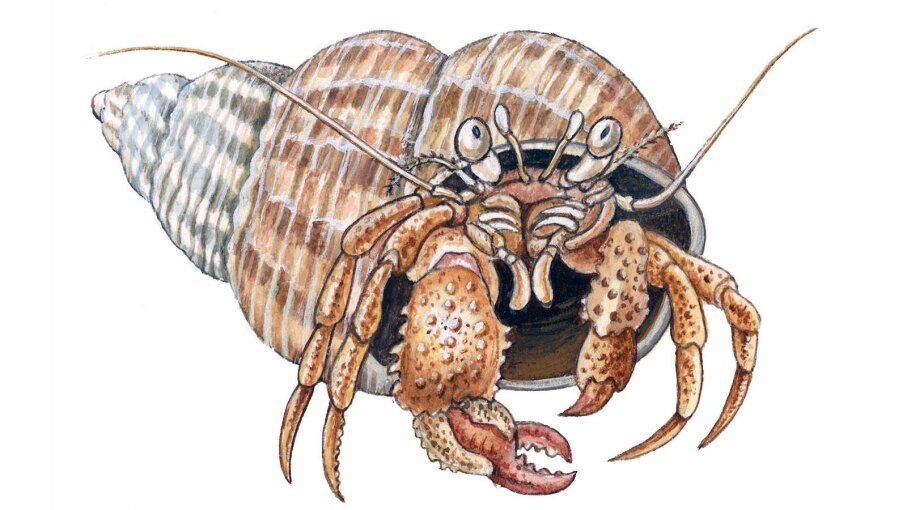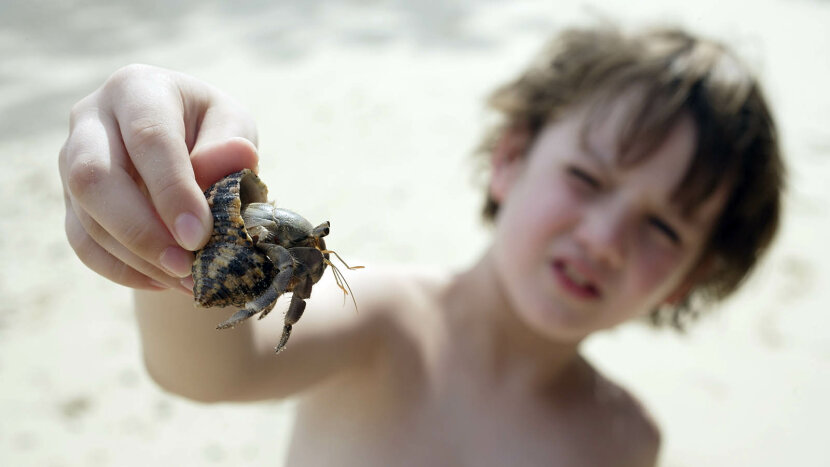
Hermit Crabs: Tiny Crustaceans Living in Nature's Mobile Homes
by Mark ManciniAdvertisement
Sandals, seashells and anchor magnets. These are the goodies we expect to find at beach town souvenir stores. During the 1970s, another mainstay joined the usual lineup: live hermit crabs.
Baby turtles were once the pet of choice for small children across the United States. But in the Decade of Disco, their popularity took a hit due to concerns about salmonella. And that's when hermit crabs took off. Selling like hotcakes at coastal giftshops, they quickly spread inland. Now you can pick up supplies for the tiny crustaceans at just about any pet store.
Unfortunately, hermit crabs — like betta fish — are often bought on impulse. Before taking one home, make sure you've done your research. Here's a brief (but by no means comprehensive) introduction to their natural history and care.
Crabs Galore!
Hermit crabs are related to porcelain crabs and squat lobsters and make up the superfamily paguroidea. Worldwide, there are around 800 species, including the gargantuan, rat-eating coconut crab.
Swimming With the Sharks
Will a Shark Drown if It Stops Moving?
Basking Sharks Look Ferocious, But Prefer Plankton to People
Some "hermies," as enthusiasts call them, are fully aquatic and others spend the bulk of their lives on dry land. Shell appropriation is one thing most species have in common. To protect their vulnerable abdomens, the majority of hermit crabs occupy shells that were originally made by mollusks, such as snails.
Hermit crabs bought in the U.S. usually belong to one of two species: Coenobita compressus or Coenobita clypeatus. The latter is an icon of the Caribbean Sea, where it scuttles across islands and mainland habitats alike. It has circular eyes — and the claws on most individuals are a deep shade of purple. Hence, they've been nicknamed "purple pincher" crabs, or PPs for short. Beyond the claws, other regions of the body may look reddish, grayish or tan.
Coenobita compressus has a more uniform complexion. Its claws have the same general shade as its limbs, head and abdomen. Also, the eyes are oval-shaped, being taller than they are wide. Popularly known as the "Ecuadorian hermit crab," it's sometimes called the "Eccie." How adorable!
The Ideal "Crabitat"
Building the right "crabitat" for your spineless buddies can be a rewarding process. Yet the challenge is not to be taken lightly. Hermit crabs are often sold in itty-bitty plastic carrying containers. Don't mistake these for permanent enclosures; the active crustaceans demand way more space.
Moreover, hermies need company. Yes, we know the word "hermit" implies that these guys are a bunch of loners. But they're not. Eccies, PPs and related species form colonies out in the wild, giving them a measure of security while the animals seek food and shelter.
To stay healthy, captive hermit crabs must socialize. So don't just buy or adopt one of them. Instead, make sure your crabitat includes at least two hermies of the same species.
While you're at it, get yourself a glass-walled tank. A pair of hermit crabs will require a setup at least 12 inches (30 centimeters) tall by 10 inches (25 centimeters) wide and 20 inches (51 centimeters) long. Enclosures of those dimensions are marketed as "10-gallon" aquariums/terrariums in the states.

A "Crabulous" Atmosphere
Being creatures of the tropics, hermies like humid living spaces. Keep your tank's humidity level at 75 to 85 percent and monitor it with a good hygrometer. You'll also need a terrarium thermometer — and see to it that the temperature stays between 72 and 82 degrees Fahrenheit (22.2 and 27.7 degrees Celsius).
Sunlight and passing breezes can really screw up the internal environment, so don't place your crabitat next to a window.
How does one maintain a steady crabitat climate? Well when it comes to heating, you've got a few different options. Some keepers use overhead lamps, undertank heaters, or a combination of both. Just stick to products specifically designed for hermit crabs and other cold-blooded animals.
Humidifiers, foggers and daily sprayings from handheld plant misters can help you achieve optimum humidity. For best results, place a sturdy lid on top of the enclosure that isn't riddled with excess holes. You don't want to block outside air completely, but screen lids allow too much moisture to escape — unless they're (mostly) covered in some kind of wrap or paneling.
Surf and Turf
Because chlorine is hazardous to hermies, tap water's a no-go; only expose your crabs to dechlorinated water. And speaking of hydration, your pets will need two separate water dishes. Fill one with freshwater and the other with saltwater. Table salt with iodine can harm the hermies so you shouldn't use it. Use sea salt instead.
An ideal dish will be deep enough for the crabs to immerse themselves — but make sure they can climb back out! (Natural sponges are wonderful hermie ramps.)
Quality substrate is a keeper's best friend. Proper bedding makes it easier to maintain the right humidity level and it lets hermies indulge in their favorite hobby: burrowing. The Hermit Crab Association suggests that novice keepers use a mixture of cocofiber and play sand. A crabitat's bedding should be at least twice as deep as its biggest occupant is tall.
OK, so you've laid down the substrate and bought your water dishes. What comes next? Decor, decor, glorious decor! Hermit crabs are avid climbers, so they'll appreciate branches and hunks of driftwood. Above-ground shelters — like hollowed-out logs — should also be provided.
And oh yeah, don't forget to add a shallow food tray. Captive hermies will eat everything from sardines and scrambled eggs to applesauce and tofu. Bear in mind that their exoskeletons need plenty of calcium, just like your bones.
The Matter of Molting
Speaking of exoskeletons, hermit crabs have to replace these hardened body coverings periodically as the crustaceans grow. If you notice a change in one of your crab's eating or digging habits, it could be due for a molt. Other signs may include sloth, color change and the regeneration of lost limbs.
Cage-mates can injure or kill crabs during this vulnerable process, so some keepers transfer their pets to a temporary isolation enclosure when molting seems imminent. Should you find a newly shed exoskeleton lying around, don't remove it; hermies recover essential nutrients by eating these.
Once the process is complete, your buddy will want to ditch its old seashell and climb into a slightly bigger one. Always keep extra shells inside the crabitat for this very purpose.
With the proper care, hermies can live for decades; one owner celebrated her crab's 40th birthday (that she knew of) in 2016. Named Jonathan Livingston Crab, this female — yes, female — PP was originally purchased in 1976. The hobby's come a long way since then. So has our body of knowledge about hermit crab husbandry. We hope your clawed companions bring you many years of happiness.
Now That's Terrifying
So ... about those coconut crabs. Found on tropical islands in the Pacific and Indian Oceans, they can weigh almost 9 pounds (4 kilograms) and their maximum leg span is in the ballpark of 3.2 feet (1 meter). That makes them the world's biggest land-based crustaceans. Rats are unusual fare for the giants; typically, coconut crabs eat smaller creatures, carrion, fruits, seeds and vegetable matter. Poke one at your own risk.